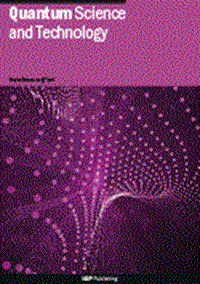用探测器分束法进行玻色子采样的实验验证
IF 5.6
2区 物理与天体物理
Q1 PHYSICS, MULTIDISCIPLINARY
引用次数: 0
摘要
我们通过实验证明了一种玻色子采样器的测试策略,该策略基于多个光学模式的输出光子计数分布的有效可计算表达式。我们将该方法应用于可重构光子芯片上的三光子玻色子采样实验,该芯片实现了一个四模干涉仪,分析了50个haar随机幺正变换,同时通过控制延迟调整光子的不可区分性。我们表明,对于(几乎)不可区分的光子,实验准确地再现了理想的玻色子采样盒模分布,其表现出的变化取决于所实施的特定干涉仪以及盒的选择,证实了该方法在诊断部分可区分性或芯片控制不完美等缺陷方面的实用性。最后,我们分析了哈尔平均分束模式分布与不可分辨性的关系,并分析证明了其方差与光子不可分辨性参数平方的平均值成正比。这些发现突出了分束在玻色子采样验证中的核心作用,为评估多光子干涉和实验性能提供了一个可扩展和有效的框架。本文章由计算机程序翻译,如有差异,请以英文原文为准。
Experimental validation of boson sampling using detector binning
We experimentally demonstrate a testing strategy for boson samplers that is based on efficiently computable expressions for the output photon counting distributions binned over multiple optical modes. We apply this method to validate boson sampling experiments with three photons on a reconfigurable photonic chip, which implements a four-mode interferometer, analyzing 50 Haar-random unitary transformations while tuning photon indistinguishability via controlled delays. We show that for (nearly) indistinguishable photons, the experiment accurately reproduces the ideal boson sampling binned-mode distributions, which exhibit variations that depend both on the specific interferometer implemented as well as the choice of bin, confirming the usefulness of the method to diagnose imperfections such as partial distinguishability or imperfect chip control. Finally, we analyze the behavior of Haar-averaged binned-mode distributions in relation to indistinguishability and demonstrate analytically that its variance is proportional to the average of the square of the photons’ indistinguishability parameter. These findings highlight the central role of binning in boson sampling validation, offering a scalable and efficient framework for assessing multiphoton interference and experimental performance.
求助全文
通过发布文献求助,成功后即可免费获取论文全文。
去求助
来源期刊

Quantum Science and Technology
Materials Science-Materials Science (miscellaneous)
CiteScore
11.20
自引率
3.00%
发文量
133
期刊介绍:
Driven by advances in technology and experimental capability, the last decade has seen the emergence of quantum technology: a new praxis for controlling the quantum world. It is now possible to engineer complex, multi-component systems that merge the once distinct fields of quantum optics and condensed matter physics.
Quantum Science and Technology is a new multidisciplinary, electronic-only journal, devoted to publishing research of the highest quality and impact covering theoretical and experimental advances in the fundamental science and application of all quantum-enabled technologies.
 求助内容:
求助内容: 应助结果提醒方式:
应助结果提醒方式:


